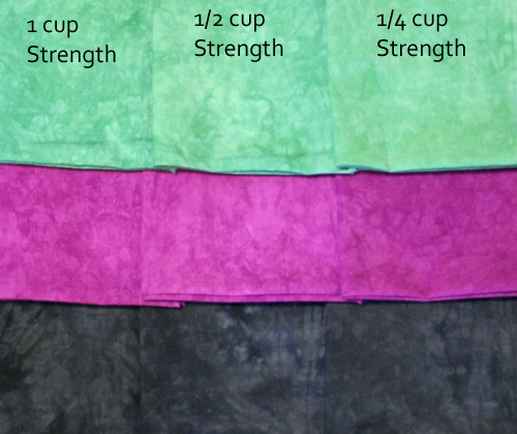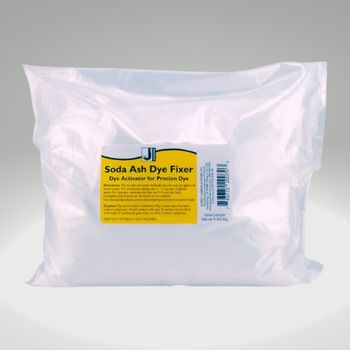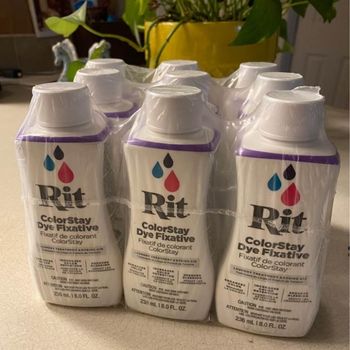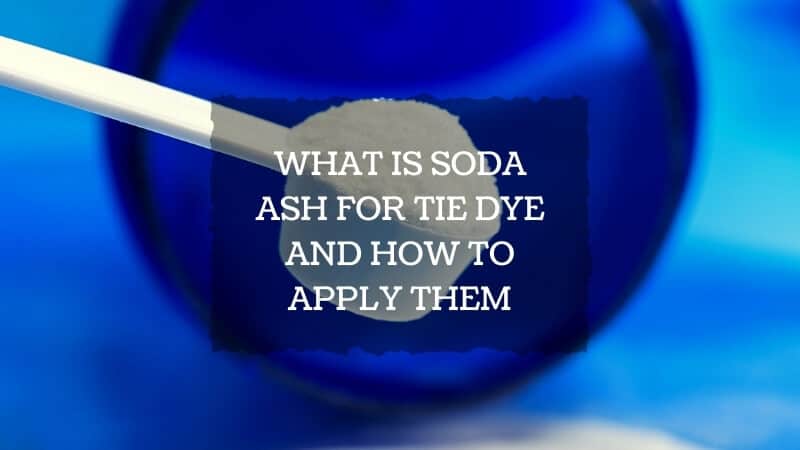What is Soda Ash for Tie Dye and How to Apply Them?
When it comes to dyeing auxiliaries—especially for fiber reactive dyes—the use of alkali, such as soda ash, is inescapable. As more and more people are getting into the art of tie dyeing, they fascinate about its function and inner-workings.
To successfully indulge in any craft, one needs to understand its basics. And that’s exactly what this article is all about. You’ll get to know all about this chemical, from its chemistry to where you can get the best soda ash for tie dye.
You might also be surprised to know that this is used as an active ingredient in cleaners like carbona color run remover and other detergents.
So, without further ado, let’s start with answering the most obvious question:
What is Soda Ash, and Why We Use Soda Ash for Tie Dye
Soda ash, washing soda, also chemically known as Sodium Carbonate (Na2CO3) is a mild alkali. A lot of people misunderstand that soda ash and baking soda are the same things. Baking soda is Sodium bicarbonate (NaHCO3) which possesses less basic attribute than soda ash. If we talk in general, the basic reason of using soda ash is to increase the pH level.
There are assorted forms of soda ash available to hand containing a handful number of water molecules; these hydro fragments escalate the size and molecular weight of the chemical. The result of using those is that a higher quantity is required to get the same effect as the others. Pure sodium carbonate apart from water units, if exposed in humid conditions for few years, absorbs water and gets hydrated.
Deca-hydrated sodium carbonate (Na2CO3.10H2O) is mostly used as washing soda, although it is three times less potent than the pure form. However, pure soda ash could also be brought into play while dyeing. As a dyer you don’t want to mistake bicarbonate for carbonate; it will cost you more as higher amount of bicarbonates squandered during dyeing when compared to the latter.
Now, let’s talk about the function of soda ash in dyeing. We all know that reactive dyes require alkaline condition to get fixed in the fiber during dyeing. Generally, washing soda enables the fixing step while dyeing and printing with PROCION dyes and REACTIVE CD dyes. Fiber reactive dyes create covalent bonds with cellulosic material after fixation and become a part of the fiber structure. The chemical reaction involved is as follows,
D-SO2-CH2-CH2-OSO3Na +OH-cell⇒ D-SO2-CH2-CH2-O-cell + NaHSO3
It is sometimes used in pre-treatment to increase scouring efficiency.
Now, the question is, “Will it be applicable for other dyes?”
The answer is simple, No! Other dyes do not require alkali for fixation like reactive dyes.
Do I Have to Use Soda Ash When Tie-Dyeing?
Not at all! If you’re not using fiber-reactive dyes like Procion MX, you can get away without using soda ash. For example, synthetic fabrics like polyester or nylon do not require the use of soda ash at all.
Also, there are many alternatives to soda ash. Some of them are already discussed in this article. So, if you don’t want to use soda ash, you can still get beautiful results with your tie-dyeing project.
What Happens If You Tie Dye Without Soda Ash?
Soda as works as a dye fixative. Meaning, it bonds the dye with your fabric. If you don’t use soda ash, the dyes will come out every time you wash your tie-dye shirt. Eventually, most of the color will get washed away.
Why Does Soda Ash Help Tie Dye?
Soda ash is a dye fixative agent. It fixes fiber-reactive dyes with cellulosic fibers like cotton. The cellulose molecule in the fabric gets converted into cellulosate anions when you add soda ash. This anion can form a covalent bond with the dye molecules easily.
This is why adding soda ash to the dye bath is an important step in the tie-dyeing process!
Can I Use Baking Soda Instead of Soda Ash for Tie Dye?
Yes, you can use baking soda as a soda ash substitute. However, keep in mind that baking soda is not as effective as soda ash. So, your results may not be as good as if you had used soda ash.
You can convert baking soda into soda ash by boiling but the process is a bit complicated and not all of the baking soda will get converted into soda ash.
Instructions on Applying Soda Ash During Tie Dyeing
How to Make Soda Ash for Tie Dye
Looking for the soda ash for tie dye instructions? Well, first, you need to know that soda ash can be applied in three distinct ways with tie dyes or any type of dyes for that matter.
Before the Addition of the Fiber Reactive Dye
Generally used in tie-dyeing. To know this process first, we should know about ‘tie-dyeing’ and then ‘tie-dyeing with soda ash.’
Tie-dyeing is a hand dyeing process in which colored patterns are generated in the fabric after dyeing. Small portions of the fabric are gathered together and tied firmly before immersing in a dyeing bath to get colored. After soaking the clothes for a pre-determined period they are opened as beautiful designs are generated on the surface; the dye particles couldn’t have penetrated into the tied section of the garments, being the reason.
People usually have fun time leisure with kids and family tie dyeing t shirts while professionals make effort to improve and implement it in machines as resist printing.
Now, let’s get to the process of tie-dyeing with soda ash. At first, half/ one cup of soda ash is added to a gallon of water before doing a little bit simmer to dissolve it. Well, you may need to make do the amount as material weight and required water volume vary.
Also, you have to remember that there’s a saturation level. Meaning, the most amount of dyes will get fixed at a particular concentration of the alkali. Adding more than that wouldn’t result in more dye pickup. Thus, you won’t notice any significant change. Check the 1/2 cup and 1/4 cup samples. There’s very little change in depth.

So, refrain from wasting your alkali (Soda Ash). 1/2 Cup of it tends to do the job most of the time. But you can experiment on it to decide which concentration works the best. Because the purity varies from batch to batch.
Now, the garments are drenched in the soda ash-water mixture from about a minimum of five minutes to around a maximum of one hour by hand using protective gloves. And finally, after that, dyes are added to the solution.
With Fiber Reactive Dyes
Soda ash could be used as one of the print paste ingredients while printing with reactive dyes. The fact that downsides this practice is shorter dye time of fabric dyes when mixed with this. However, some latter-day top grade reactive dyes, say Procion MX for example, remain dyeable for about a week. One thing as a dyer you should know, controlled temperature and humidity could bring you the best upshot.
After the Addition of Reactive Dye
This tendency is quite common in reactive dyeing of knit goods, low water-immersion and immersion dyeing processes.
Now the question is,
Is There Any Possible Alternative of Soda Ash?
Chemicals that can adjust the pH of water could turn out very useful while dyeing. Sodium hydroxide also provides alkaline pH as well as Tri-sodium phosphate (TSP). But the stress with these is that they ain’t as safe as using sodium carbonate. Sodium bicarbonate probably could have been a perfect replacement only if it conferred a greater alkaline condition. Sometimes a mixture of soda ash and sodium bicarbonate is suggested for some recipes of silk.
If we measure by weight, almost three times more sodium bicarbonate is required to get the same pH as soda ash, and it is nearly five times more when calculated by volume. Always remember to add sodium hydroxide of tri-sodium phosphate in water, not water in them. But for soda ash, this precaution isn’t that significant, it could be followed for more precise control, however.
Another supremacy of soda ash is that if you drop more or less soda ash by mistake, the deviation of pH value from the desired one is negligible. On the other hand, sodium hydroxide, being highly alkaline, changes pH swiftly. And so, obtaining actual pH could be burdensome.
When you think of substituting soda ash with other alkalis, you should check and maintain the pH adequately. Because, too high pH will deteriorate the fabric properties, and too low pH is not favorable for reactive dyeing.
Having all these said, you don’t always need clinging to sodium hydroxide, because sodium silicate could be an excellent substitute for soda ash. It is also called water glass and is generally suitable for printing with Procion MX or dyes that are similar in qualities with that.
Some Commercial Names of Sodium Silicate (Alternative of Soda Ash)
- PRO QuickFix (PRO Chemical and Dye)
- PRO Fix LHF (PRO Chemical and Dye)
- DrimaFix (Batik Oetoro)
- TobaFix (Tobasign dyes)
- AfterFix (it is available as a solution) (Dharma Trading Company)
However, there is a significant disadvantage of sodium silicate; it turns into gel in acidic exposure and it’s pretty much complicated to remove the gel. Moreover, precautionary steps should be taken to get rid of this problem. Generally, rinsing with some low alkaline solution or just water to increase the pH.
Previously mentioned that the protein fiber requires citric acid or acetic acid as they need low pH during their dyeing process. And also, the protein fibers such as wool will be damaged in alkaline conditions created by soda ash. But as using citric acid or acetic acid will not full the pH requirement for cellulosic fibers, it can not be used.
And the final question is,
Where Can You Find and Buy Soda Ash?
Grocery stores sell soda ash, but we don’t recommend you buying from them as it contains impurities (other salts or chemicals, and also the presence of dirt and dust particles), as a result not suited to dyeing.
Some of the manufacturers offer ‘Super washing soda. It is free from added or accidental impurities, however it’s hydration level is high. So, more of it will be required to reach the desired pH level compared to the the pure ones.
Stores that vend swimming pool supplies can be a place where you find pure soda ash. They keep the unadulterated form; quite understandably, maintaining pool water pH is vital.
You can of course buy soda ash for tie dye from an online platform. But make sure your’e getting it from professional hands.
We found the following two products to be the best.
1. Jacquard Soda Ash

Features
- Best Suited for : Jacquard Dyes
- Application: Tie Dye, Vat Dyeing, Batik, etc.
- Item Weight: 15.8 ounces
Jacquard Procion MX dyes being fiber reactive need a fixing agent during their dyeing process. In this case USA made Jacquard-Soda-Ash-1-Pound matches very well as a dye activator and fixer.
This 1lb handy firm packet is really worth buying for your tie dye project as it not only enables the dye particles to penetrate fabric surface well but also provides platform for the colors’ stay on the garment. Only thing you must maintain, that is to pre soak the material beforehand.
Again, the price of the product is very convincing. It’s one thing we always want to justify trying out different brands and from distinct vendors.
The packet is true to its words. 1 cup of it is required with every gallon of warm water, whereas for washers the amount of soda ash is 3 times; for a washer filled with retro clothes to be dyed needs three cups of washing soda.
However, for hand dyeing like tie dye, you might use only 1/3cup of this ingredient with every 3 gallons of water. It’s quite understandable why! With all those eye irritation possibilities when exposed closely, it’s better if the dilution occurs at higher ratio.
If you want to control the pH level of your hot dyeing bath, you could use it with ease.
PROS:
CONS:
2. Rit ColorStay Dye Fixative

Features
- Best Suited for : Rit Dyes
- Application: Tie Dye, Dip Dye, etc.
- Item Weight: 9.6 ounces
Having completed a tie dye project, what do we expect? After all the hassle and expending, of course we want our dyed wardrobes hold color before we wash them a number of times. But what if the product gets ruined at the first place only after dyeing!
Yes! Color bleeding is a common fact for professional dyers, perhaps not for a beginner. Boys T shirt (white) being the most chosen during tie dye, it leaves a definite chance of color spreading to the white surroundings of the tie design.
Rit liquid brings you the up to date solution as it offers dye fixative to stop dyed materials’ bleeding during soaking. It not only holds on the dye particles locking in them on the surface (providing higher stay) but also heightens the glow imparted during dyeing.
This product can be applied to dyed materials made from almost anything; however cotton, ramie, linen and rayon and their blends gives the best possible outcome.
PROS:
CONS:
Also, in hardware stores, you will find sodium hydroxide as lye and Tri-Sodium Phosphate as a heavy-duty cleaner.
Although this article is intended to proffer you important information about soda ash, we tried to blend few dyeing related aspects, such as tie-dyeing and tie-dyeing with soda ash. Hope it turns out handy and worthwhile to you. To enrich your knowledge further, we recommend you read the fabric dye vs tie dye article.
REFERENCES
- Chakraborty, J. N. (2015). Fundamentals and practices in colouration of textiles. WPI Publishing.
- Shenai, V. A. (1983). Chemistry of dyes and principles of dyeing.
- Shore, J., & Society of Dyers and Colourists (Eds.). (2002). Colorants and auxiliaries: organic chemistry and application properteis. Vol. 1: Colorants (2. ed.). Bradford, West Yorkshire: Society of Dyers and Colourists.
- www.pburch.net
- Shore, J., & Society of Dyers and Colourists (Eds.). (1995). Cellulosics dyeing. Bradford, West Yorkshire, England: Society of Dyers and Colourists.
- Broadbent, A. D. (2001). Basic principles of textile coloration. Bradford, West Yorkshire: Society of Dyers and Colourists.

